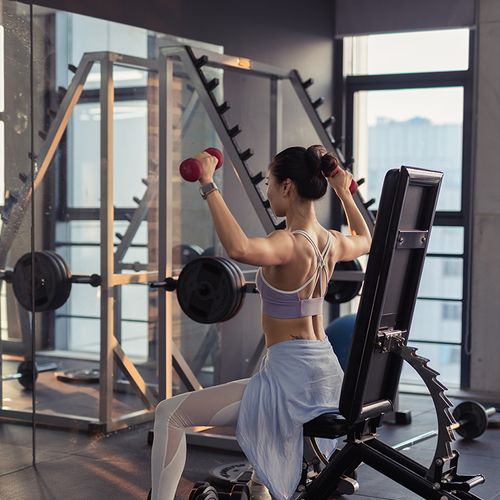Strength-training machines build muscle... fortify tendons and ligaments...increase bone density improve posture...boost mood...and raise metabolic rate so that you burn more fat.
Best: Do a strength-training workout two to three times per week, leaving at least one day between workouts so that muscles can recover. Start with a gentle warm-up of three to five minutes, doing an activity that involves the whole body, such as jumping jacks. Then use the machines for a total of 20 to 30 minutes.
Machine styles and weight increments vary depending on the manufacturer. If the machines in your gym do not have the same increments as the starting weight guidelines below, ask a trainer if it is possible to modify the options. On each machine…
- Perform one to three sets of eight to 12 repetitions, resting for one minute between each set.
- If you can't complete eight repetitions using the starting guidelines, reduce the weight. When it becomes easy to complete one set of 12 reps, try two sets, then three. When it becomes easy to do three sets, it's time to increase the weight.
- Control the motion at all times. Count slowly to two as you raise the weight...count to four as you lower the weight. This ensures that you use your muscles and not momentum to move the weights.
- Exhale as you raise the weight...inhale as you lower the weight. This helps keep blood pressure down.
Finish workouts with a three-minute walk to cool down. Then do three minutes of gentle stretching to maintain flexibility, holding each stretch for 15 to 30 seconds.
New research: Stretching promotes additional gains in strength.
Address each major muscle group to keep muscles in balance-otherwise the weaker muscles could be prone to injury. A complete workout typically includes…
Muscles worked: The latissimus dorsi (upper back) and biceps-muscles used in daily life for lifting and carrying (for example, grocery bags).
To use: Sit tall, facing the machine, with thighs tucked beneath the pads to stabilize your lower body. Reach up, palms facing you and slightly farther than shoulder-width apart, and grasp the bar hanging overhead. Squeeze shoulder blades together as you pull the bar down a few inches in front of your face...stop at chin level...then raise the bar to starting position. Start with 35 pounds if you're in your 40s...32.5 pounds in your 50s...30 pounds in your 60s...275 pounds in your 70s...25 pounds in your 80s and beyond.
Safety alert: Never pull the bar behind your head. This can injure the neck and shoulders. It is safe to grasp the bar with palms facing away—but muscles get a better workout when palms face you.
Muscles worked: Shoulders, triceps (back of the arms and base of the neck-used when placing items on a high shelf.
To use: Sit erect, hips and shoulder blades pressed against the backrest. With hands at shoulder height, palms facing forward and arms bent, grasp the outer set of handles and push up until arms are nearly straight...then lower to starting position. Start with 30 pounds if you're in your 40s...275 pounds in your 50s...25 pounds in your 60s...225 pounds in your 70s...20 pounds in your 80s and beyond.
Safety alert: If you have shoulder problems, such as with your rotator cuff, use the inner handles, palms facing each other-this is easier.
Muscles worked: Pectorals (front of the chest) and triceps-used for pushing a lawn mower or wheelchair.
To use: Sit erect with arms bent, hands at chest height, palms facing forward. Grasp handles and press forward, elbows pointing to the sides (not down), until arms are nearly straight...then bend elbows and return to starting position. Start with 35 pounds if you're in your 40s...32.5 pounds in your 50s...30 pounds in your 60s...275 pounds in your 70s...25 pounds in your 80s and beyond.
Safety alert: Do not lean forward-keep head up and entire back pressed against the backrest to avoid neck and low-back strain.
Muscles worked: Biceps and forearms—needed for lifting and carrying.
To use: Sit with arms out in front, elbows resting on the padded platform. Palms facing you, grasp handles and bend elbows to bring hands toward your chest..then straighten arms to return to starting position. Start with 30 pounds if you're in your 40s...275 pounds in your 50s...25 pounds in your 60s...225 pounds in your 70s.. 20 pounds in your 80s and beyond.
Safety alert: Elbows are prone to hyperextension-so to prevent joint injury when lowering the bar, stop when elbows are still slightly bent. If your lower back arches, reduce the weight to prevent back strain.
Muscles worked: Quadriceps and hamstrings (fronts and backs of thighs), inner thighs and buttocks—vital for walking and climbing stairs.
To use: Sit and recline against the backrest, legs raised in front of you, knees at a 90-degree angle, feet flat and hip-width apart on the movable platform. Slowly straighten legs until knees are almost straight, pressing with heels to push platform away...then bend knees to return to starting position. Start with 85 pounds if you're in your 40s...80 pounds in your 50s. 75 pounds in your 60s...70 pounds in your 70s...65 pounds in your 80s and beyond.
Safety alert: To protect knees, do not straighten legs completely...keep thighs parallel to align knees.
Muscles worked: Abdominals—which help maintain posture and combat belly bulge.
To use: Sit and place feet behind ankle pads to stabilize lower body...grip handles and place elbows on padded rests to stabilize upper body. Using abdominal muscles, curl upper body forward to bring your chest toward your knees...then uncurl as far as possible without letting weights return to the resting position. Start with 40 pounds if you're in your 40s...375 pounds in your 50s. 35 pounds in your 60s...325 pounds in your 70s...30 pounds in your 80s and beyond.
Safety alert: Keep head and spine aligned to prevent neck injury.
